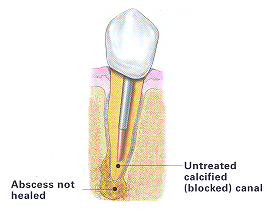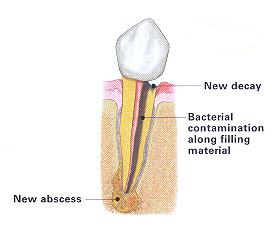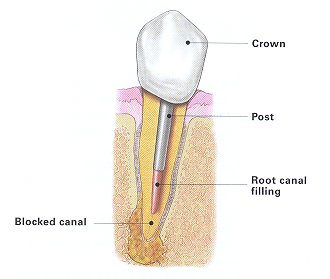Procedures
Endodontic Retreatment
A second chance to save your tooth!
With proper care, most teeth that have had endodontic (root canal) treatment can last as long as other natural teeth. In some cases however, a tooth that has received endodontic treatment fails to heal or the pain continues. Occasionally the tooth becomes painful or diseased months or even years after successful treatment. If your tooth has failed to heal or has developed new problems, you have a second chance. Another endodontic procedure may be able to save your tooth.
Why do I need another endodontic procedure?

As occasionally happens with any dental or medical procedure, a tooth may not heal as expected after initial treatment for a variety of reasons.
- Narrow or curved canals were not treated during the initial procedure.
- Complicated canal anatomy went undetected in the first procedure.
- The crown or other restoration was not placed soon enough after the procedure.
- The restoration did not prevent saliva from contaminating the inside of the tooth.

In some cases, a new problem can jeopardize a tooth that was successfully treated. For example:
- New decay can expose the root canal filling material to bacteria, causing a new infection in the tooth.
- A loose, cracked, or broken crown or filling can expose the tooth to new infection.
What will happen during retreatment?

First, the endodontist will discuss your treatment options. If you and your endodontist choose retreatment, the endodontist will reopen your tooth to gain access to the root canal filling material. In many cases, complex restorative materials – crowns, post, and core material – must be disassembled and removed to permit access to the root canal.
After removing the canal filling, the endodontist can clean the canals and carefully examine the inside of your tooth, carefully searching for any additional canals or unusual anatomy that requires treatment.
After cleaning the canal(s), the endodontist will fill and seal the canal(s), and place a temporary filling in the tooth*. Post space may also be prepared at this time.
After the final visit with your endodontist, you will need to return to your dentist as soon as possible to have a new crown or other restoration placed on the tooth to protect and restore it to full function.
NOTE: * If the canals are unusually narrow or blocked, your endodontist may recommend endodontic surgery. This surgery involves making an incision near the end of the root to allow the tip of the root to be sealed.
Is retreatment the best choice for me?
Retreated teeth can function well for years, even for a lifetime. It’s always best to save the tooth if your endodontist believes retreatment is the best option for you.
Advances in technology are constantly changing the way root canal treatment is performed, so your endodontist may even be able to use a new technique that was not available when you had your first procedure. If your tooth has unusual anatomy that was not cleaned or sealed during the first procedure, your endodontist may resolve this problem with a second treatment.
Of course, there are no guarantees with any dental or medical procedure. Your endodontist will discuss your options and the chances of success before beginning retreatment.
What is the alternative to retreatment?
For some patients considering retreatment, endodontic surgery is also an option. This surgery involves making an incision near the end of the root to allow the tip of the root to be sealed. Endodontic surgery may be recommended in conjunction with retreatment as an alternative. Your endodontist will discuss your options and recommend appropriate treatment.
The only other alternative is extraction of the tooth. The extracted tooth must then be replaced with an implant, bridge, or removable partial denture to restore chewing function and to prevent adjacent teeth from shifting. Because these options require extensive surgery or dental procedures on adjacent, healthy teeth, they can be far more costly and time consuming than retreatment and restoration of the natural tooth.
No matter how effective modern tooth replacements are – and they can be very effective – nothing is as good as your natural tooth. You’ve already made an investment in saving your tooth. The payoff for choosing retreatment could be a healthy, functioning natural tooth for many years to come.
